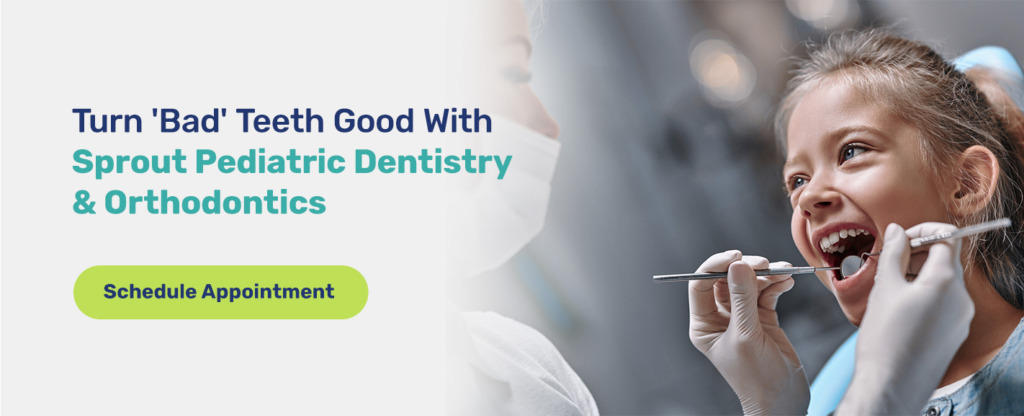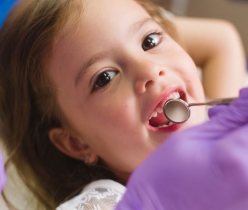When it comes to your child’s oral hygiene, you’re a superstar. You’ve taught them how to floss. You always stock the fridge with low-sugar snacks. And when their teeth fall out, you make a fantastic tooth fairy. So, why does your child keep getting cavities? The fact is, sometimes “bad” teeth happen to good kids.
What Causes Kids ‘Bad’ Teeth
Take comfort in the fact that your child is not alone. According to a report by the American Academy of Pediatrics, more than 40% of children aged 2 to 19 experience dental cavities. Many factors contribute to tooth decay in children, from biological to environmental. To understand how to treat “bad” teeth, we must first know what causes them. Here are some of the most common culprits.
Dental Plaque
Do you ever get a fuzzy feeling in your mouth when you haven’t brushed? The cause is dental plaque, a sticky coating that contains bacteria. We all have bacteria living inside our mouths. However, when we eat meals containing sugar, the bacteria release enamel-attacking acid. Daily brushing and regular visits to the dentist help get rid of plaque. However, left alone, plaque can cause cavities.
Cavities aren’t contagious, but cavity-causing bacteria may travel through saliva. Saliva can pass through shared toys, eating utensils or kissing.
Diet and Nutrition
What your child puts into their mouth impacts dental health. Sugary and carbohydrate-rich foods are the diet of choice for cavity-causing bacteria. When it comes to the role of food in tooth decay, some facts may surprise you:
- Carbohydrates contribute to cavities: Sugar is not the only culprit in tooth decay. Fermentable carbohydrates break down into sugar inside your child’s mouth. Examples include white bread and potato chips. Bacteria love to carb-load on these kinds of foods.
- Bedtime bottles breed bacteria: The American Dental Association (ADA) advises against putting your child to bed with a bottle. Sugary liquids can pool around the front teeth, causing baby bottle tooth decay.
- Time and frequency matter: How long acid stays in the mouth contributes to decay. Certain foods, like toffee or raisins, stick to the teeth and remain until brushing time. Frequency also matters. Eating snacks or sipping juice throughout the day increases the risk of cavities.
Hygiene Habits
Poor oral hygiene habits increase the risk of tooth decay. The best way to prevent plaque is through regular brushing and flossing. The frequency and technique of cleaning are essential. Brushing twice per day and flossing at night with the right technique is a good way to go.
Fluoride is an important weapon in the fight against cavities in kids. It strengthens enamel and prevents the tooth’s surface from breaking down. Dental hygiene products like toothpaste and mouthwash contain fluoride. Some parents are unsure about fluoride’s safety for children. It’s worth researching this topic or speaking with your dentist to see if it’s right for you.
Tooth Structure
The anatomy of your child’s teeth may make them more susceptible to cavities. For example, grooves are great for music but not for teeth. The grooves make a perfect spot for food particles to get stuck. If your child has “groovy” teeth, there’s more chance of bacteria and plaque buildup. Genetics and illness can also result in weaker tooth enamel.
Saliva
Think of saliva as a bath for your mouth — it cleans debris from the tooth surface. Saliva also contains minerals and calcium that help strengthen teeth. A child’s saliva may not wash their mouth effectively if there isn’t enough of it or if it’s too thick. Medical conditions such as diabetes can affect saliva production.
Medications
Children’s medications often contain sugar to make them more tasty. However, these medications also provide bacteria with a delicious treat. Gummy vitamins top this list. Both sticky and sweet, they can get stuck in the teeth and create a plaque party.
Some pharmaceuticals, such as asthma inhalers, affect saliva and cause dry mouth. As mentioned, saliva washes away plaque-causing food and bacteria. Be aware of medications that contribute to “bad” children’s teeth.
How to Treat Children’s ‘Bad’ Teeth
There’s hope for kids with “bad” teeth. Here are a few ways that you can keep your child’s teeth in tip-top condition.
Early Intervention and Prevention
With dental health, prevention is better than cure. Cavities can form even on baby teeth. The ADA recommends taking your baby for their first dental checkup around their first birthday or within six months of their first tooth.
From there, you can schedule regular cleanings and checkups with a pediatric dentist. A trained pediatric dentist identifies and addresses any risks before they become problematic. They can guide and educate you to help prevent oral issues from developing. Of course, they can also treat cavities or dental problems that crop up!
Pediatric dentists offer the following preventive services for children:
- Dental exam: The dentist examines your child’s mouth to check for signs of decay. They also check mouth health, including the gums, jaws and soft tissues.
- Teeth cleaning: Regular cleaning removes tartar and stains. Dentists can also demonstrate proper brushing and flossing techniques.
- Fluoride treatment: Various fluoride treatments can improve your child’s oral health. The benefits of fluoride for children are well-documented. If you have concerns, address these with your dentist.
- X-rays: A dentist X-rays the mouth to identify issues invisible to the naked eye. X-rays take place only when needed.
- Sealants: Dentists coat the tooth’s surface to prevent plaque and debris from settling into grooves.
- Silver diamine fluoride: Applied to the area of decay, this medication kills bacteria.
Good Oral Hygiene Routine
You can start your child on a path toward dental health when their first tooth pops up! Regular cleaning disturbs the bacteria in the mouth to stop plaque from forming.
Tips for top oral hygiene include:
- Brushing your child’s teeth twice a day from when their first tooth appears.
- Flossing as soon as your child has two teeth that touch.
- Using fluoride toothpaste to strengthen tooth enamel.
- Educating your little one on the importance of good hygiene habits.
When your child is old enough to take over dental hygiene, show them proper flossing and brushing techniques. Introducing rewards or games is a great way to get children invested in their dental health. For example, you might reward them with a trip to the movie theater when they remember to floss every day for two weeks.
Mouth-Healthy Nutrition
Nutrition contributes to children’s growth and oral development. Here are diet tips for excellent dental health:
- Limit sugar intake: Most foods contain some form of sugar. Read labels and choose low-sugar options where possible.
- Serve a well-balanced diet: Your child should eat a combination of fruits, vegetables, grains, dairy and lean proteins. Visit MyPlate from the United States Department of Agriculture to learn about food groups.
- Snack smart: Substitute sweets or sugary treats for nutritious snack options.
- Water over juice: Hydration helps with saliva production, which is good for mouth health! Choose water over juice wherever possible, and avoid giving your child juice in sippy cups or bottles.
Turn ‘Bad’ Teeth Good With Sprout Pediatric Dentistry & Orthodontics

The sooner you start your child on a journey toward good oral hygiene, the better! At Sprout Pediatric Dentistry & Orthodontics, we’re committed to your child’s dental health. Your kids will feel like superheroes in the fight against “bad” teeth. Our warm practice environment makes dentist visits something to look forward to.
Cavities don’t stand a chance against our holistic approach. We offer preventive treatments to stop tooth decay in its tracks. Let’s work together to keep your child’s smile healthy and bright! Contact Sprout Pediatric Dentistry & Orthodontics today to schedule an appointment or learn more.

Dr. Dana grew up in Portland and went to Temple University in Philadelphia, PA for dental school. She then moved to Anchorage, AK for her residency in Pediatric Dentistry. Dr. Dana takes a holistic approach to pediatric dentistry & is able to use her own parenting experience to sympathize and understand each family’s unique dynamic.



